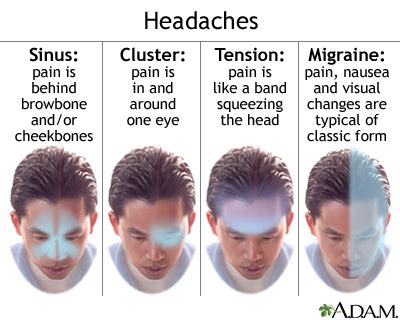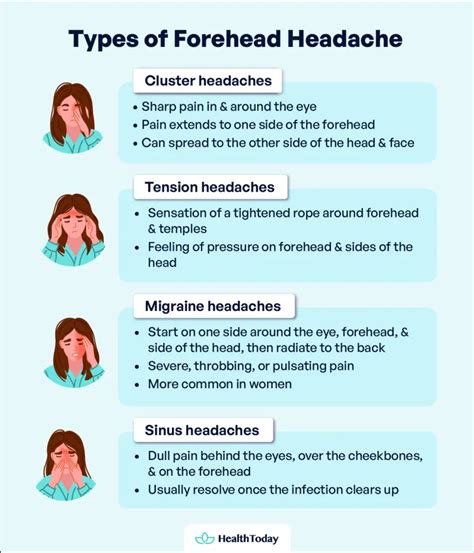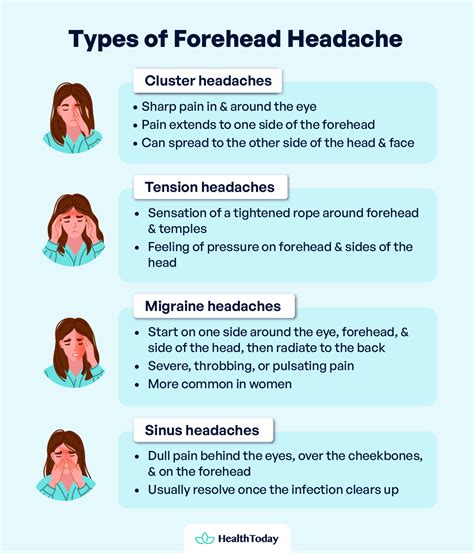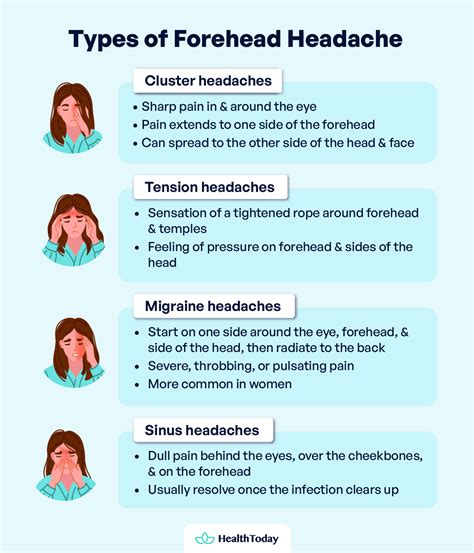Intro
Discover causes and relief for headache in center of forehead, including tension, sinus, and migraine headaches, with expert tips on pain management and prevention.
Headaches can be a debilitating and frustrating experience, affecting daily life and overall well-being. One common type of headache is the headache in the center of the forehead, which can be caused by a variety of factors. Understanding the possible causes, symptoms, and treatment options for this type of headache is essential for effective management and relief. In this article, we will delve into the world of forehead headaches, exploring the importance of addressing this issue and the benefits of seeking medical attention when necessary.
Headaches in the center of the forehead can be a symptom of an underlying condition, and it is crucial to identify the root cause to develop an effective treatment plan. Some possible causes of forehead headaches include tension, sinus pressure, eye strain, and poor posture. Additionally, certain medical conditions, such as migraines, cluster headaches, and temporal arteritis, can also cause forehead pain. By understanding the potential causes of forehead headaches, individuals can take the first step towards finding relief and improving their quality of life.
The experience of a headache in the center of the forehead can vary from person to person, with some individuals describing it as a dull ache, while others may experience a sharp, piercing pain. The pain can be constant or intermittent, and it may be accompanied by other symptoms, such as sensitivity to light, sound, or smell. In some cases, forehead headaches can be a warning sign of a more serious underlying condition, emphasizing the importance of seeking medical attention if the pain is severe, persistent, or accompanied by other concerning symptoms.
Causes of Forehead Headaches

Forehead headaches can be caused by a variety of factors, including tension, sinus pressure, and eye strain. Tension headaches, for example, are often characterized by a dull, aching pain in the forehead, neck, and scalp, and are typically caused by muscle tension, stress, and poor posture. Sinus pressure, on the other hand, can cause pain and pressure in the forehead, cheeks, and nose, and is often accompanied by congestion, runny nose, and facial pain. Eye strain, which can be caused by prolonged use of digital devices, reading, or other visually demanding activities, can also lead to forehead headaches, as well as eye fatigue, blurred vision, and dry eyes.
Tension Headaches
Tension headaches are one of the most common types of headaches, affecting millions of people worldwide. They are often described as a dull, aching pain in the forehead, neck, and scalp, and can be caused by a variety of factors, including muscle tension, stress, and poor posture. Tension headaches can be triggered by a range of factors, including:- Muscle tension: Tight muscles in the neck, scalp, and face can lead to tension headaches.
- Stress: Emotional stress, anxiety, and depression can contribute to tension headaches.
- Poor posture: Poor posture can lead to muscle strain and tension, which can cause headaches.
- Lack of sleep: Insufficient sleep or disrupted sleep patterns can contribute to tension headaches.
Sinus Pressure
Sinus pressure is another common cause of forehead headaches, and is often accompanied by congestion, runny nose, and facial pain. Sinus pressure can be caused by a range of factors, including:- Sinus infections: Bacterial or viral infections can cause sinus pressure and forehead headaches.
- Allergies: Seasonal allergies, dust, and other environmental allergens can contribute to sinus pressure and headaches.
- Cold or flu: Respiratory infections can cause sinus pressure, congestion, and forehead headaches.
- Anatomical issues: Deviated septum, nasal polyps, or other anatomical issues can contribute to sinus pressure and headaches.
Symptoms of Forehead Headaches

The symptoms of forehead headaches can vary from person to person, but common symptoms include:
- Pain or pressure in the forehead, cheeks, and nose
- Congestion, runny nose, and facial pain
- Eye strain, fatigue, and blurred vision
- Sensitivity to light, sound, or smell
- Nausea and vomiting
- Dizziness and lightheadedness
In some cases, forehead headaches can be a warning sign of a more serious underlying condition, such as a migraine, cluster headache, or temporal arteritis. It is essential to seek medical attention if the pain is severe, persistent, or accompanied by other concerning symptoms.
Migraines
Migraines are a type of headache disorder characterized by recurrent episodes of severe headaches, often accompanied by sensitivity to light, sound, and smell. Migraines can cause forehead headaches, as well as other symptoms, including:- Severe pain or pressure in the forehead, cheeks, and nose
- Sensitivity to light, sound, and smell
- Nausea and vomiting
- Dizziness and lightheadedness
- Aura: Some people may experience an aura, which can include visual disturbances, such as flashing lights or zigzag patterns.
Cluster Headaches
Cluster headaches are a type of headache disorder characterized by recurrent episodes of severe headaches, often occurring in clusters or cycles. Cluster headaches can cause forehead headaches, as well as other symptoms, including:- Severe pain or pressure in the forehead, cheeks, and nose
- Redness and swelling of the eye and eyelid
- Nasal congestion and runny nose
- Sweating and flushing of the face
- Restlessness and agitation
Treatment Options for Forehead Headaches

Treatment options for forehead headaches depend on the underlying cause, and may include:
- Over-the-counter pain relievers, such as acetaminophen or ibuprofen
- Prescription medications, such as triptans or ergots
- Lifestyle changes, such as stress management, regular exercise, and healthy sleep habits
- Alternative therapies, such as acupuncture, massage, or chiropractic care
- Surgery, in some cases, to correct anatomical issues or relieve pressure on the sinuses or nerves.
It is essential to consult with a healthcare professional to determine the best course of treatment for forehead headaches, as they can help diagnose the underlying cause and develop an effective treatment plan.
Lifestyle Changes
Lifestyle changes can play a significant role in managing forehead headaches, and may include:- Stress management: Techniques such as meditation, deep breathing, or yoga can help reduce stress and alleviate headaches.
- Regular exercise: Regular physical activity can help reduce tension and improve overall health.
- Healthy sleep habits: Establishing a consistent sleep schedule and creating a relaxing sleep environment can help improve sleep quality and reduce headaches.
- Healthy diet: Eating a balanced diet rich in fruits, vegetables, and whole grains can help reduce inflammation and alleviate headaches.
Alternative Therapies
Alternative therapies, such as acupuncture, massage, or chiropractic care, can also be effective in managing forehead headaches. These therapies can help:- Reduce tension and stress
- Improve sleep quality
- Alleviate pain and pressure
- Improve overall health and well-being
It is essential to consult with a healthcare professional before starting any alternative therapy, as they can help determine the best course of treatment and ensure safe and effective care.
Prevention of Forehead Headaches

Prevention is key when it comes to forehead headaches, and there are several steps that can be taken to reduce the risk of developing headaches. These include:
- Practicing good posture and taking regular breaks to stretch and move
- Managing stress and anxiety through relaxation techniques, such as meditation or deep breathing
- Getting regular exercise and maintaining a healthy weight
- Eating a balanced diet rich in fruits, vegetables, and whole grains
- Avoiding triggers, such as certain foods or environmental allergens
By taking these steps, individuals can reduce their risk of developing forehead headaches and improve their overall health and well-being.
Good Posture
Good posture is essential for preventing forehead headaches, as it can help reduce muscle tension and alleviate pressure on the sinuses and nerves. Tips for maintaining good posture include:- Keeping the head in a neutral position, with the ears in line with the shoulders
- Keeping the shoulders back and down, with the chest open and relaxed
- Keeping the spine straight, with the hips and knees at a 90-degree angle
- Avoiding slouching or leaning forward, which can put pressure on the neck and shoulders
Stress Management
Stress management is also crucial for preventing forehead headaches, as stress can contribute to muscle tension and alleviate pressure on the sinuses and nerves. Techniques for managing stress include:- Meditation: Focusing on the breath and letting go of distracting thoughts can help reduce stress and alleviate headaches.
- Deep breathing: Taking slow, deep breaths can help calm the mind and body, reducing stress and tension.
- Yoga: Practicing yoga can help reduce stress and alleviate headaches, as well as improve overall health and well-being.
What are the most common causes of forehead headaches?
+Forehead headaches can be caused by a variety of factors, including tension, sinus pressure, eye strain, and poor posture. Tension headaches, sinus infections, and migraines are also common causes of forehead headaches.
How can I prevent forehead headaches?
+Prevention is key when it comes to forehead headaches. Practicing good posture, managing stress and anxiety, getting regular exercise, eating a balanced diet, and avoiding triggers can help reduce the risk of developing headaches.
What are the best treatment options for forehead headaches?
+Treatment options for forehead headaches depend on the underlying cause, and may include over-the-counter pain relievers, prescription medications, lifestyle changes, alternative therapies, and surgery. It is essential to consult with a healthcare professional to determine the best course of treatment.
In conclusion, forehead headaches can be a debilitating and frustrating experience, affecting daily life and overall well-being. By understanding the possible causes, symptoms, and treatment options for this type of headache, individuals can take the first step towards finding relief and improving their quality of life. We encourage readers to share their experiences and tips for managing forehead headaches, and to consult with a healthcare professional for personalized advice and care.
